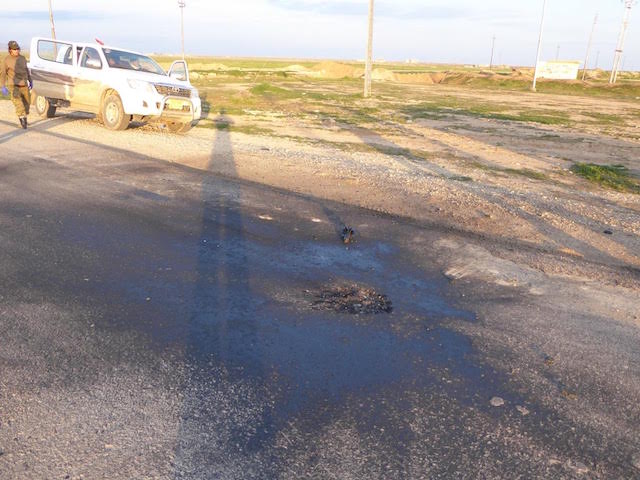According to an eyewitness in Northern Iraq, Islamic State jihadists used chemical weapons against the Kurdish Peshmerga this week. Dave Eubanks with the Free Burma Rangers witnessed the use of chemical weapons by the terror group during a current relief mission in Iraqi Kurdistan, where he is helping internally displaced persons (IDP) and doing medical treatment and training.
In a statement on Thursday, February 11, Eubanks reported:
ISIS fired over thirty 81 mm mortar projectiles from two tubes with chemical munitions vicinity south of Sinjar, Kurdistan, Northern Iraq. The rounds landed in an open field 200 meters behind the new front line berm. The wind was blowing 10-15 knots southwest to northeast paralleling the front line and thus most of the gas was blown away from the troops and dissipated.
Eubanks noted that he is not sure what kind of chemical was used. He was told that it was chlorine, but he cannot personally confirm that assessment.
Eubanks stated that thirty Peshmerga became very sick, had difficulty breathing, some vomited and had stinging nose and eyes. “They were evacuated to the clinic in Sinjar town and treated there. They recovered and returned to duty,” he wrote.
Writing in an email, Eubanks stated that they “photographed both sites immediately after the attack (we were giving medical training nearby), and there was a strong smell of rotten vegetables, and there was a burning in our noses and eyes” and said it smelled like chlorine and sulfur. “There was a black tar like substance around the impact area of the chemical round. The Peshmerga also told us that theses were chlorine gas shells” he wrote.
During an interview with CBS News’ 60 Minutes, CIA director John Brennan said that Islamic State fighters have used chemical weapons and have the capability to make small quantities of chlorine and mustard gas.
“We have a number of instances where ISIL has used chemical munitions on the battlefield,” stated Director Brennan during the interview.
He continued, “There are reports that ISIS has access to chemical precursors and munitions that they can use.”
When asked by CBS News about the capability of exporting those chemical weapons to the West, Brennan responded, “I think there is always potential for that. This is why it is so important to cut off the various transportation routes and smuggling routes they can use.”
Brennan’s comments came two days after the Director of National Intelligence James Clapper confirmed before a Senate Armed Services Committee that the “Islamic State has succeeded in making and deploying chemical agents in Iraq and Syria – calling it the first such attack by an extremist group in more than two decades.”
Director Clapper stated that this marks the first time an extremist group has produced and used a “chemical warfare agent in an attack since Aum Shinrikyo used sarin in Japan in 1995,” referring to the Tokyo subway terror attack that year.
Speaking to Breitbart News on the phone, Dave Eubanks stated that the Peshmerga, and Yezidi Peshmerga, have pushed ISIS 3-5 kilometers outside the city line, south of Sinjar City. “They have a long berm and a new frontline descending. ISIS launches numerous attacks at different parts of the line, but have failed to effectively breach the front line,” he said.
“It seems like ISIS is on their back foot,” Eubanks said. He continued, saying that the “front line runs from the Syrian border, down to south of Sinjar, around close to Tel Afar, close to Mosul Dam area and loops around to Bashiqa, down to Gwer and past Erbil.”
“ISIS is plenty capable of breaching any point of the line, but it would be only temporarily breached it seems; strong Peshmerga positions and coalition airpower would make it very difficult for ISIS to hold and gain any territory,” Eubanks stated.
Eubanks highlighted the importance that the defensive line in the Sinjar area still leaves thousands of Yezidis trapped inside of ISIS-controlled areas. He said Yezidis are asking him why the offensive was stopped during the liberation of Sinjar City. “They are asking me why it stopped when they had ISIS on the run and why didn’t they continue to push ISIS out of all the Yezidi villages because there are still thousands of Yezidi women and children held captive,” he stated.
Even though ISIS is pushed back they are still controlling many Yezidi villages, he said.
Eubanks told the story of a father, a Peshmerga soldier, who has a wife, a 4-month-old and 2-year-old, that was captured by ISIS a year ago and they are still held by ISIS. The Peshmerga soldier told him that his wife is probably a sex slave and he does not know if his children are alive. There are many stories like this father’s, whose relatives still held captive by ISIS.
Eubanks also discussed how the new front lines have opened up the terrain so that many mass graves have been discovered. He said that he visited a mass grave today, where 90 people were buried in one grave, stating “there are many mass graves, 20-30 of them, hundreds of people that have been discovered since ISIS was pushed back from Sinjar City in November.”
He also commented on how ISIS supply trucks are still seen traveling to and from Syria into Iraq. He said, “traffic was slowed down by taking Highway 47 from Syria into Sinjar City in November, but now they have a road network south running parallel to HWY 47 that over 100 vehicles at night were seen traveling on the new route. Supply trucks are still coming in from Syria into Iraq and back and forth through another road network just south of Highway 47.”
Tera Dahl is Executive Director of the Council on Global Security.


COMMENTS
Please let us know if you're having issues with commenting.